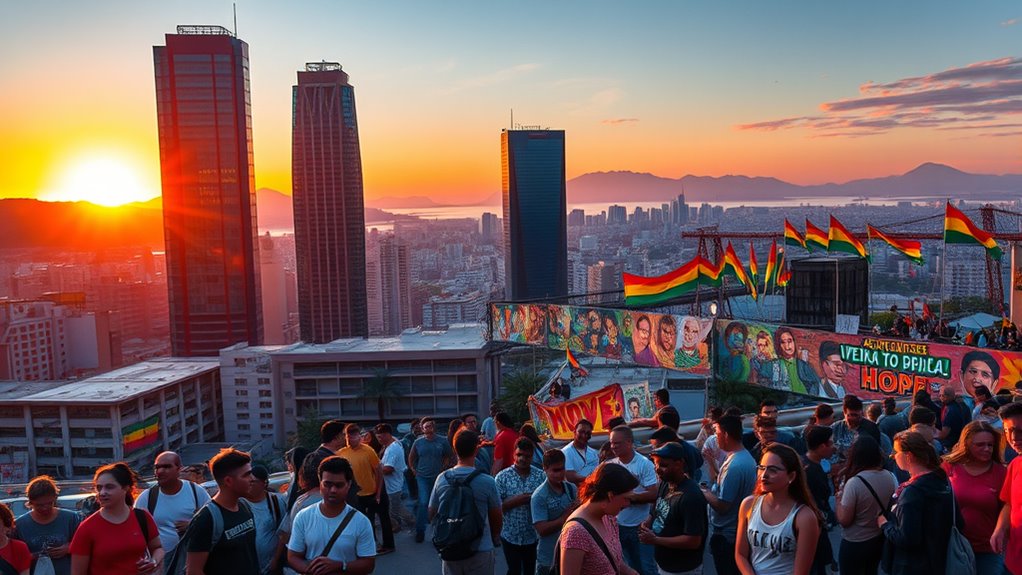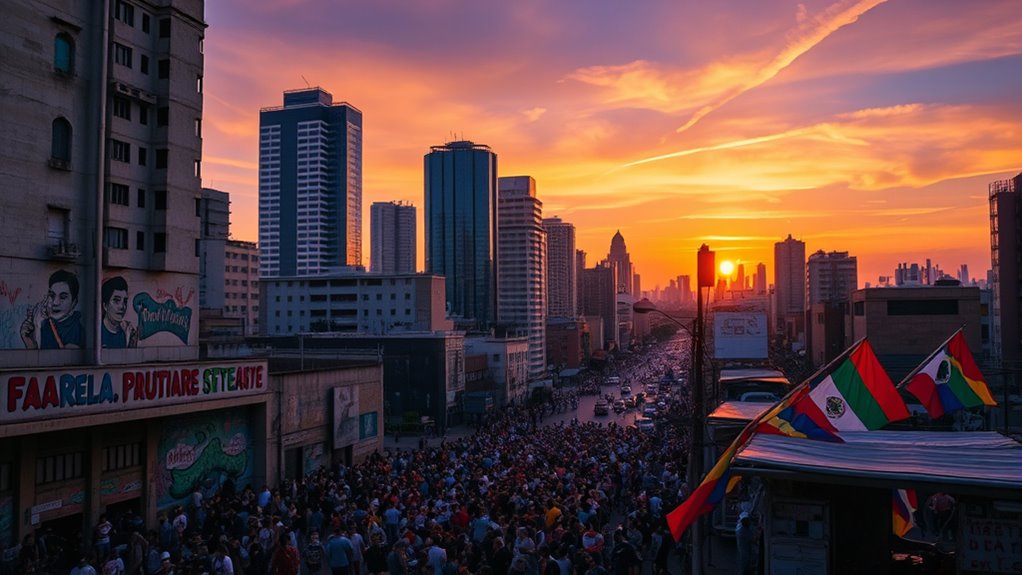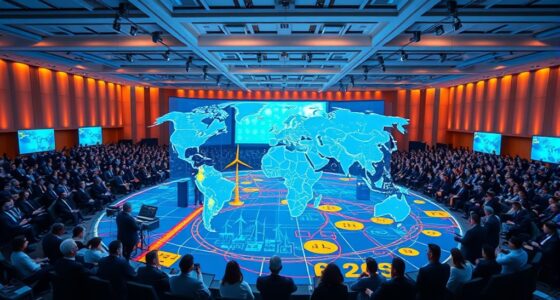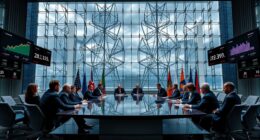By 2025, Latin America’s landscape will be shaped by rising populist movements that challenge traditional governance, leading to political volatility. Economic uncertainties will grow as governments shift policies toward protectionism or social reforms, impacting investments. Social demands for equality and better services will increase, often causing protests and unrest. Managing these intertwined political, social, and economic changes requires careful strategies. If you want to understand how these developments could influence opportunities and risks in the region, keep exploring further.
Key Takeaways
- Political populism will continue to influence governance, leading to increased instability and unpredictable policy environments.
- Latin America’s economic growth will depend on managing populist pressures and maintaining investor confidence amid policy uncertainties.
- Trade and energy policies may shift toward protectionism or reform, affecting foreign investment strategies and regional cooperation.
- Social demands for reforms in healthcare, education, and labor rights will shape political agendas and stability prospects.
- The region’s future stability hinges on balancing populist movements, social cohesion, and strategic economic policies.

As Latin America approaches 2025, the region stands at a pivotal crossroads, with economic growth, political shifts, and social changes shaping its future trajectory. You’ll notice that populist movements continue to influence governments across the continent, often driven by discontent with traditional elites and economic inequality. These movements tend to promote policies that appeal to the masses, emphasizing sovereignty and social redistribution, but they can also introduce unpredictability into the political landscape. This instability makes foreign investors cautious, as they seek stable environments to deploy capital. Despite the region’s rich natural resources and emerging markets, foreign investments have fluctuated, impacted by political rhetoric, policy uncertainty, and concerns over governance. For investors, the challenge lies in balancing the potential high returns with the risks posed by shifting political alliances and populist agendas that may prioritize short-term gains over long-term stability.
Latin America’s future hinges on populist policies, political stability, and social demands shaping investment risks and opportunities.
You’ll also see that the rise of populist leaders often results in a reevaluation of international relationships. Governments may adopt more protectionist policies or renegotiate trade agreements to favor domestic industries, which can complicate foreign investment strategies. While some countries push for increased economic nationalism, others seek to attract foreign capital by offering incentives or easing regulations. This tug-of-war influences everything from infrastructure projects to energy policies, shaping the investment climate. As a result, you might notice a pattern where countries oscillate between openness and protectionism, creating a dynamic yet uncertain environment for foreign investors. This landscape demands that you stay informed about political developments and policy changes to assess risks accurately. Additionally, the evolving economic landscape requires investors to adapt strategies in real time to capitalize on emerging opportunities.
Meanwhile, social demands continue to grow, fueling protests and calls for reform across sectors like education, healthcare, and labor rights. These social shifts often intertwine with populist rhetoric, emphasizing the need for greater equality and government accountability. Such movements can force governments to prioritize social spending or implement reforms, which may either attract or deter foreign investment depending on their impact on economic stability. You need to understand that these social and political currents are interconnected; they shape the investment environment and influence the region’s economic prospects. While some countries aim to leverage social reforms to foster stability and development, others face setbacks due to political polarization or unrest.
In essence, as 2025 approaches, Latin America’s future hinges on how governments navigate populist pressures, manage foreign investments, and respond to social demands. Your perspective as an observer or investor must account for these intertwined factors, recognizing that the region’s path will be defined by political resilience, economic policies, and social cohesion. The choices made today will determine whether Latin America emerges as a more stable, prosperous region or continues to grapple with volatility.
Frequently Asked Questions
How Will Climate Change Impact Latin America’s Economic Growth by 2025?
Climate change will likely hinder Latin America’s economic growth by 2025 if you don’t prioritize climate resilience and economic diversification. You’ll face more frequent disasters, damaging key industries like agriculture and tourism. Without diversifying your economy and strengthening resilience, your region risks slower growth, increased inequality, and greater vulnerability. To thrive, you must adopt sustainable practices and invest in adaptable infrastructure, ensuring your economy remains resilient despite climate challenges.
What Role Will Technology Play in Shaping Political Reforms in Latin America?
You will see technology revolutionize political reforms in Latin America like never before. Digital governance will become your new reality, making government more transparent and responsive. Cybersecurity reforms will safeguard your rights and data, preventing chaos and corruption. This digital wave will empower citizens, shake up old power structures, and create a future where politics are transparent, accountable, and driven by innovation—changing your everyday life forever.
How Might Demographic Shifts Influence Regional Stability and Policy Priorities?
You’ll see demographic shifts like youth migration and aging populations impact regional stability and policy priorities. Youth migration can drain talent and energy from local communities, while aging populations increase healthcare and pension demands. These changes push you to adapt social services and economic strategies, balancing the needs of older citizens with opportunities for young people. Managing these shifts effectively will be vital for maintaining stability and fostering sustainable growth in Latin America.
What Are the Potential Impacts of International Trade Agreements on Latin America’s Economy?
Trade treaties translate into tangible benefits, boosting your economy through better market access and reducing trade dependencies. You’ll see increased investment, innovation, and industry growth, fueling financial stability. However, trade dependencies could also deepen, making your economy vulnerable to global fluctuations. You must carefully craft policies that maximize market access while minimizing reliance, ensuring sustainable, strong, and stable economic growth amidst the dynamic, diverse global trade landscape.
How Will Social Movements Influence Political Change in Latin American Countries?
Social movements will substantially influence political change in Latin America by harnessing grassroots activism and social media influence. You’ll see more citizens organizing protests and advocating for reforms, which pressures governments to respond. Social media amplifies these efforts, spreading awareness quickly and mobilizing larger groups. This dynamic increases political engagement, challenges traditional power structures, and pushes for policies aligned with popular demands, ultimately shaping the region’s political landscape.
Conclusion
By 2025, Latin America faces both promising political shifts and tough economic challenges. Did you know that the region’s GDP is projected to grow by only 2% annually? This slow pace highlights the need for reforms and stability. If you pay attention to these changes, you’ll see how strategic decisions now could shape Latin America’s future, turning challenges into opportunities for growth and development. Stay informed, and you’ll better understand the region’s evolving landscape.










